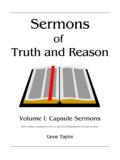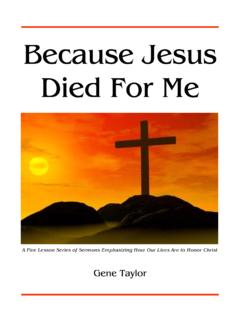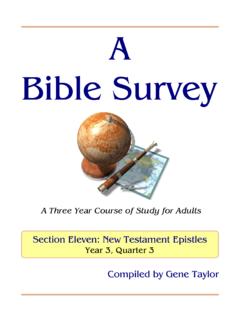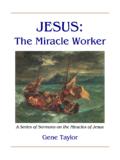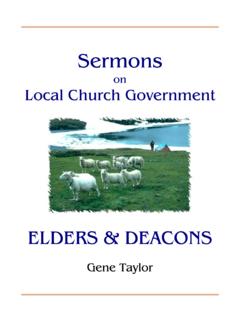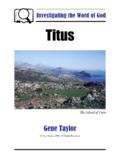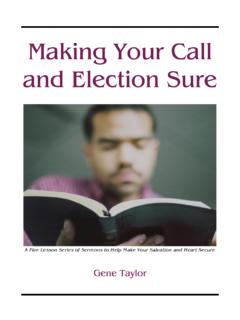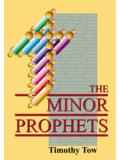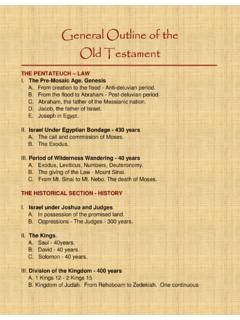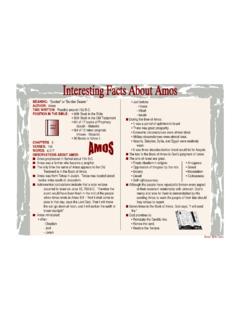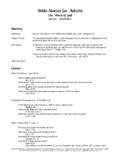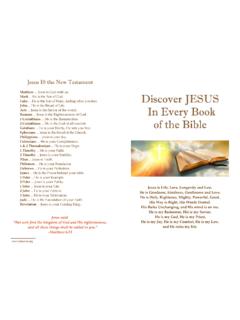Transcription of Between the Testaments - Centerville Road
1 Between the Testaments A Study of the 400 Years of Biblical Silence and the Relevant Empires Gene Taylor Table of Contents Table of Contents .. 1. Lesson One: The Kingdom Years - A Short History .. 2. Lesson Two: The Assyrian Empire .. 5. Lesson Three: The Babylonian Empire .. 8. Lesson Four: The Medo-Persian Empire .. 12. Lesson Five: The Grecian Empire .. 16. Lesson Six: The Ptolemies .. 19. Lesson Seven: The Seleucids .. 22. Lesson Eight: The Maccabean Revolt and the Hasmonean Dynasty .. 24. Lesson Nine: The Roman Empire .. 27. Lesson Ten: The Herods and Samaritans .. 30. Lesson Eleven: The Sects of the Jews .. 33. Lesson Twelve: Developments Among the Jews .. 37. Gene Taylor, 2005. All Rights Reserved. The Period Between the Testaments Gene Taylor -1- The Kingdom Years A Short History I.
2 The United Kingdom During the lifetime of Samuel, the last judge of Israel, the Israelites rejected God's system of rule by judges and demanded a king in order to be like the nations around them (1 Sam. 8:1-8). Saul was anointed by Samuel to be king. He reigned for forty years. He displeased God so God did not allow any of his descendants to rule. David, a man after God's own heart (1 Sam. 13:14; Acts 13:22), was anointed by Samuel as Kings of the United Kingdom second king over Israel. He, being a good military leader, subdued all the nations which afflicted Israel Saul 1050-1010 . and spread the borders of Israel expanding the David 1010-970 . territory over which he ruled. God promised him that Solomon 970-930.
3 His kingdom would endure forever (2 Sam. 7:11-16). David was succeeded by Solomon, his son. He built the empire of Israel to its peak of earthly glory (1 Kings 4:20-25). He supervised an impressive building program. In addition to the royal palace, he built the temple in Jerusalem which his father, David, had been forbidden to build. II. The D ivided Kingdom Israel Following Solomon's death, the nation was divided into two kingdoms. Israel, the northern kingdom, Kings of Israel consisted of ten tribes. Jeroboam was its first king (931-910 ). The southern kingdom, Judah, Jeroboam 930-909 . consisted of the two tribes of Benjamin and Judah. Nadab 909-908 . Rehoboam was its first king (931-913 ). Baasha 908-886 . Of the twenty kings who ruled over Israel, not a Elah 886-885.
4 One was good. From its beginning, Israel practiced Zimri 885 . idolatrous worship. Tibni 885-880 . Jeroboam, at the onset of his reign and the Omri 885-874 . establishment of his kingdom, erected idols in Dan Ahab 874-853 . and Bethel so that the people would not go to Ahaziah 853-852 . Jerusalem to worship and be enticed to ally Joram (Jehoram) 852-841 . themselves with Rehoboam and the people of Judah. Jehu 841-814 . As time went on, Israel sank into terrible depths of idolatry and sin. God, though, did not give up on Jehoahaz 814-798 . these people. Jehoash (Joash) 798-782 . God sent prophets to turn the hearts of the people Jeroboam II 793-753 . back to Him and His law. Such men as Elijah, Elisha, Zachariah 753-752.
5 Amos and Hosea sought to get the people to repent. Shallum 752 . Amos (755 ), for example, condemned unjust Menahem 752-742 . social practices, extravagant but empty formal Pekahiah 742-740 . worship, and the political corruptions. Hosea's life Pekah 740-732 . typified God's love for His rebellious people who Hoshea 732-722 . were involved in spiritual harlotry just as Gomer, Hosea's wife, played the harlot. The Period Between the Testaments Gene Taylor -2- Sadly, Israel did not heed God's warnings. She fell to Assyria in 722 (2 Kings 17). She went into a captivity from which she never returned. III. The Divided Kingdom - Judah In contrast to the wickedness of Israel's kings, Judah had some good kings among those who ruled her.
6 They made great efforts to destroy idolatry and Kings of Judah restore the worship God had commanded. Rehoboam 930-910 . When Assyria tried to take Judah, King Abijam 913-911 . Hezekiah (716-687 ), a good king, appealed to Asa 911-870 . the prophet Isaiah who prayed to God to spare His Jehoshaphat 870-848 . people. God slew 185,000 Assyrians in one night Jehoram (Joram) 848-841 . and Judah was spared (2 Kings 19:35-37). God Ahaziah 841 . continued to spare Judah for a few more years Athaliah 841-835 . because of the influence of such good kings as Joash (Jehoash) 835-796 . Hezekiah and Josiah (641-609 ). Amaziah 796-767 . During this time, though, Judah was becoming Uzziah (Azariah) 767-740 . more corrupt thus storing up judgment for herself.
7 Jotham 740-732 . Periodically the kings of Judah turned the people Ahaz 732-716 . Hezekiah 716-687 . back to God but usually their righteousness was Manasseh 687-643 . short-lived for their penitence was superficial. Amon 643-641 . Josiah, for example, cast down all the idolatrous Josiah 641-609 . images but he could not take the idols from the Jehoahaz 609 . hearts of the people. Jehoiakim 609-598 . As he had to Israel, God sent His prophets to Jehoiachin 598-597 . Judah. Isaiah (740-690 ) prophesied during the Zedekiah (Mattaniah) 597-586 . reigns of Uzziah (767-740 ), Jotham (740-732. B .C .), Ahaz (732-716 B .C .), and Hezekiah. He spoke against the vices of Judah and warned her of God's wrath. He also painted a bright picture of her future glory awaiting her after her redemption.
8 Micah, a contemporary of, Isaiah (735-700 ), cried out against the social injustices of greed and oppression of the poor which had come about because of the great prosperity Judah enjoyed. Zephaniah (630-625 ) saw the Chaldeans, the Babylonians, as a growing threat to Judah. Jeremiah (625-586 ) spent 40 years trying to avert the Babylonian captivity .He warned the people they would be taken as slaves to Babylon for 70 years (Jer. 25:11). No one heeded his warning. Habakkuk (612-606 ) cried to God because of the wickedness of Judah and the doom on the horizon in the form of the Babylonians. He prophesied that God's judgment was coming on Judah to purge her of her evil (Hab. 1:5-6). IV. The Babylonian Captivity Judah fell to the Babylonians in 606 Jerusalem was captured by King Nebuchadnezzar (604- 562.)
9 B .C .) in 597 B .C . It, along with the temple, was destroyed in 586 B .C . Many of the people were taken captive and transported to Babylon for a period of 70 years. Daniel (606-536 ) and Ezekiel (593-573. B .C .) prophesied of God's protection during the captivity and restoration of the people to their land. The Period Between the Testaments Gene Taylor -3- V. The Restoration of a Remnant True to God's promises, after 70 years of captivity, Cyrus (559-530 ), the Medo-Persian king who had conquered the Babylonians, allowed the Jews to return to their homeland. The first group returned from captivity under Joshua and Zerubbabel (Ezra 1-4). They began to rebuild the temple. The altar was restored and the foundations laid but then the work was stopped.
10 The people went about their own business of rebuilding their own houses, etc. About 16 years after the work was stopped, God sent two prophets, Haggai (520 ) and Zechariah (520-518 ), to get the people to resume work on the temple. They did and the temple was completed in 516 , some 70 years after the destruction of the previous temple (Ezra 5-6). The second group of captives, under the leadership of Ezra, returned to Jerusalem in 458 In 444. B .C ., Nehemiah, a Jew who was cupbearer to King Artaxerxes (464-424 B .C .) of the Medo-Persian empire, came to Jerusalem and led the people to rebuild the walls of the city. A century after the return of the first exiles, the people became indifferent to the moral and ceremonial aspects of the law.

